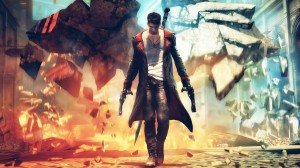Psst. Hey buddy, you want in on a hot trend? It’s all the rage.
What’s that? These look like old boots to you? Naw, these are reboots. Don’t you know that recycling is good for ya?
Let’s face it, the video game industry is like Hollywood’s little brother, always trying to follow in the steps carved out by its more popular sibling. And given the fact Hollywood reboots are commonplace (thanks in large part to the success of relaunched properties such as Star Trek, The Amazing Spider-Man, X-Men and Planet of the Apes), is it really surprising that video game franchises are trying to follow stride?

Dante’s new look isn’t the only change you’ll find in the franchise reboot DmC: Devil May Cry, available on Xbox 360 and PlayStation 3.
Not really.
Gaming franchises have been rebooted over the years, look no further than Fallout 3, The Elder Scrolls IV: Oblivion and even Super Mario. Heck, a little more than a month from now, we’ll be getting our hands on the love new iteration of gaming icon/vixen Lara Croft, when the rebooted Tomb Raider franchise goes gold.
Today, though, you can get your hands on a hot new reboot: DmC: Devil May Cry – developed by British studio Ninja Theory and published by Capcom on the Xbox 360 and PlayStation 3 consoles.
Devil May Cry 4, the last game in the popular franchise, came out in 2008 and was a critical success. But with this new retelling of the story of a pair of demon-fighting brothers, Ninja Theory and Capcom have overhauled everything from the ground up, opting for a darker, grittier approach.
That quickly becomes evident from DmC’s hyper-stylized introduction to main character Dante, who we meet during a music-driven sequence in which a pair of angel wing-wearing strippers grind each other in a nightclub before going home with our hero for a little ménage-a-trois action.
Yep, that’s definitely new.
The thing is, it works in every way imaginable.
DmC offers a fluid, action-heavy ride that is punctuated by stylish melee and pistol-powered combos and conflicted characters who have big, power-imbued axes to grind, literally and figuratively.
The story centres on twin brothers – Dante and Vergil – born to a father who was a demon and a mother who was an angel. The duo are reunited after being hidden away from the evil Mundus, the demon their father, Sparda, betrayed after falling in love with Eva, their mother. They are hell-bent on carving out a little payback because Mundus killed Eva and sentenced Sparda to unending torment on the other side.
Adding to the mix is the fact the brothers are Nephilim … half-demon, half-angel. And only Nephilim possess the power required to beat the demon Mundus.
The game takes place on two planes of existence.
In the real world, Mundus, in the guise of a Lex Luthor-esque human, owns a corporate media outlet to spread his propaganda. He owns the debts of major nations, making their politicians his tools. And he keeps the masses submissive through the use of a popular energy drink.
In Limbo, Mundus’ demonic forces run wild and this is where Dante does battle. Using his sword, Rebellion, and twin pistols, Ebony and Ivory, Dante unleashes both ground-based and aerial attacks, seamlessly shifting between the two. In fact, the game rewards you for mixing up the combos in an endless stream of flashing blades and blazing guns. Use the same combo over and over and you’ll actually lose style points for being, well, mundane and boring.
But because Dante is a half-breed, Rebellion can be imbued with both angelic and demonic powers. Holding down the left trigger brings up Osiris, an angelic scythe that slices and dices at great speeds. Holding the right brings up the Arbiter, a demonic axe whose slow attacks are mitigated by the fact they are powerful, breaking through defensive shields in short order.
The combos are remarkably simple to use, but offer gamers plenty of choice.
The enemy AI is a bit uneven at times. Some demons move with the speed of old school zombies, while others can go all 28 Days Later on you. There are five difficulty settings (some of which are unlocked only by finishing the game at lower levels), which means that just about anyone can pick up and play DmC and feel challenged depending on their experience level.
The art direction is stunning. The environments are visually arresting, with unique colour palettes highlighting the different planes of existence.
And the voice acting is remarkably good. The characters have depth and easily draw you in, making you invest in their journey from the opening scene to the awesome final battle.
DmC doesn’t completely ignore its heritage. There’s a moment early on in the first mission when a white-blonde wig lands on the head of the ‘new’ Dante – a nod to the character’s previous look. However, after studying his reflection for a couple seconds, Dante doffs the wig and chucks it away, dismissing the locks with a disdainful “Not in a million years” retort.
But don’t completely dismiss the notion, Dante. Sometimes looks have a way of coming back en vogue.
DmC is rated M for mature.
Wayne Chamberlain has covered the gaming industry since 2002. He is the co-host of the Star Wars Book Report podcast, available on iTunes, and a contributing writer with Postmedia News and Canada.com.